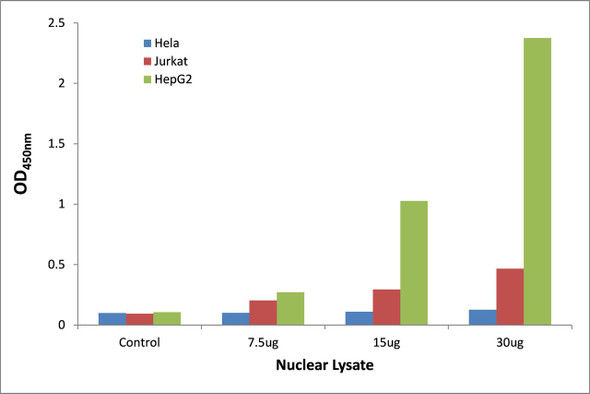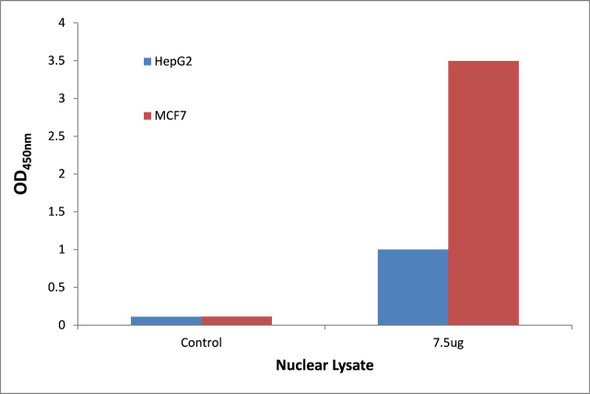Description
| Product Name: | HOXA11/D11 Transcription Factor Activity Assay |
| Product Code: | TFAB00123 |
| Target: | HOXA11/D11 |
| Synonyms: | Homeobox protein Hox-1I |
| Reactivity: | Human, Mouse |
| Sample Types: | Nuclear or cell lysates |
The Assay Genie HOXA11/D11 transcription factor activity assay allows for the detection and qualitative analysis of endogenous levels of activated transcription factors in a variety of nuclear and cell lysates
Assay Genie ELISA kits are designed to significantly reduce experiment time and ensure sensitivity and flexibility for high-throughput screening.
| Assay Time: | 4.5 hours |
| Detection Method: | Colorimetric 450 nm |
| Size: | 12 x 8-Well Microstrips |
| Storage: | 4°C for 6 months |
| UniProt Protein Function: | HOXA11: Sequence-specific transcription factor which is part of a developmental regulatory system that provides cells with specific positional identities on the anterior-posterior axis. Defects in HOXA11 are the cause of radioulnar synostosis with amegakaryocytic thrombocytopenia (RSAT). The syndrome consists of an unusual association of bone marrow failure and skeletal defects. Patients have the same skeletal defects, the proximal fusion of the radius and ulna, resulting in extremely limited pronation and supination of the forearm. Some patients have also symptomatic thrombocytopenia, with bruising and bleeding problems since birth, necessitating correction by bone marrow or umbilical-cord stem-cell transplantation. Belongs to the Abd-B homeobox family. |
| UniProt Protein Details: | Protein type:Transcription factor; DNA-binding Chromosomal Location of Human Ortholog: 7p15.2 Cellular Component: transcription factor complex; protein complex; nucleus Molecular Function:sequence-specific DNA binding Biological Process: embryonic forelimb morphogenesis; developmental growth; anatomical structure morphogenesis; transcription, DNA-dependent; multicellular organismal development; positive regulation of transcription, DNA-dependent; male gonad development; uterus development; anterior/posterior pattern formation; positive regulation of chondrocyte differentiation; dorsal/ventral pattern formation; ureteric bud branching; single fertilization; induction of an organ; mesodermal cell fate specification; spermatogenesis; embryonic digit morphogenesis; skeletal development; metanephros development; proximal/distal pattern formation; embryonic limb morphogenesis Disease: Radioulnar Synostosis With Amegakaryocytic Thrombocytopenia |
| NCBI Summary: | In vertebrates, the genes encoding the class of transcription factors called homeobox genes are found in clusters named A, B, C, and D on four separate chromosomes. Expression of these proteins is spatially and temporally regulated during embryonic development. This gene is part of the A cluster on chromosome 7 and encodes a DNA-binding transcription factor which may regulate gene expression, morphogenesis, and differentiation. This gene is involved in the regulation of uterine development and is required for female fertility. Mutations in this gene can cause radio-ulnar synostosis with amegakaryocytic thrombocytopenia. [provided by RefSeq, Jul 2008] |
| UniProt Code: | P31270 |
| NCBI GenInfo Identifier: | 13124744 |
| NCBI Gene ID: | 3207 |
| NCBI Accession: | P31270.2 |
| UniProt Related Accession: | P31270 |
| Molecular Weight: | |
| NCBI Full Name: | Homeobox protein Hox-A11 |
| NCBI Synonym Full Names: | homeobox A11 |
| NCBI Official Symbol: | HOXA11 |
| NCBI Official Synonym Symbols: | HOX1; HOX1I; RUSAT1 |
| NCBI Protein Information: | homeobox protein Hox-A11 |
| UniProt Protein Name: | Homeobox protein Hox-A11 |
| UniProt Synonym Protein Names: | Homeobox protein Hox-1I |
| UniProt Gene Name: | HOXA11 |
| UniProt Entry Name: | HXA11_HUMAN |






